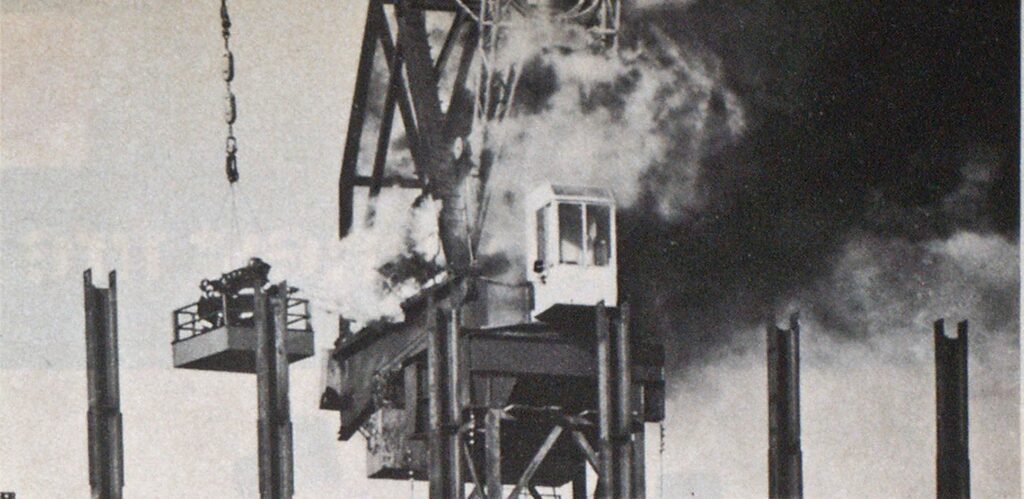
High-Rise Fire a Problem When Standpipe Not Installed
features
Fire fighters responding to a fire in a crane above the 16th floor of an Atlanta building under construction found that water was not available because the building’s required standpipe system had not been installed. A difficult operation was begun to stretch a hose line up the side of the building. Then the fire was quickly extinguished.
The Georgia-Pacific Center building will eventually become the corporate headquarters of this large company. At the time of the fire, the steel had been erected to the 16th floor of an eventual 52 floors. Seven floors already had the poured, reinforced concrete in place. Above these the steel skeleton of the building areas contained temporary wooden flooring and wooden forms awaiting the floor concrete. Materials were being lifted to the working levels by two diesel-driven cranes above the highest steelwork.
The fire protection standpipe had not been installed in any of the structure. This was a violation of an Atlanta ordinance which adopted chapter 8 of the National Fire Codes, 1976 edition, and NFPA Standard 14, chapter 8-1, concerning buildings under construction in excess of 100 feet. This standard has a subitem under paragraph 8-1.1, which states: “Standpipe shall be carried up with each floor and securely capped at the top. Top hose outlets should at all times be not more than one floor below the highest forms, staging and like combustibles.”
If this ordinance had been obeyed, water would have been available less than two floors below the fire location.
At 4:49 p.m. last Feb. 4, the Atlanta Bureau of Fire Services communications room received a call for a fire in a crane on top of the Georgia-Pacific building. The initial alarm brought in Engines 4, 6 and 11 with Ladders 4 and 11 and Third Battalion Chief Kenneth Allen. These companies found the diesel compartment of one of the two cranes heavily involved in fire. The majority of the work force had left for the day.
Companies got to the other crane by way of work elevators and stairs. Several fire fighters were then lifted with portable extinguishers near the burning crane to see if a dry chemical and CO2 attack could knock out the flames. But batteries in the unit exploded, spreading the fire, and the extinguisher attack was meeting with little success.
Allen requested the duty fire commander, Chief E. O. McDonnell, to respond and take command of the street level so Allen could proceed to the fire floor and get a closer look at the situation. This is standard procedure in Atlanta. Fifth Battalion Chief Charlie Rice was requested for the Ellis St. side of the building to oversee fire operations from the street level to the north of the fire building.
Since there was no standpipe, the suppression and cooling attack was severely delayed, leading construction officials to fear that the brakes on the crane’s boom cables might give way and send the boom crashing onto the top steel of the building or possibly into Houston St. below. Fire bureau equipment was relocated away from the danger area.
Hoisted hose straight up
In the meantime, sections of 2 1/2-inch hose were being hoisted to the upper floors by fire crews with a rope which had been lowered from the top. In all, 500 feet were used. Companies secured the hose to the building’s steel framework at the 5th, 10th and 16th-floor levels. This line was then slowly charged by Engine 4, so as not to strain the couplings. When water was obtained at the top of the building, the fire was quickly brought under control.
It was determined that the fuel tanks on the crane never became involved in the fire and were not causing the explosions being reported by news media at the scene. These pops were probably the batteries. The brakes did not fail and the boom did not move, as was earlier feared.
In the operation, 19 fire fighters, under the overall direction of Deputy chief of Field Operations A. D. Bell, were needed to bring the fire under control. Care was taken to ensure that fire personnel and equipment were kept clear of the area where the crane might have fallen, and no injuries were reported.
The crane had fire damage throughout the engine compartment. Extensive rebuilding was required before it could be returned to service.
The building received no damage as a result of the incident. However, if the fire had occurred later when the building was higher, it is possible that the vertical hose would have required support at every floor because of the greater weight of the couplings. That would take much longer. And obviously the volume of flame could have been much greater if fire had dropped into the wooden decking and forms for concrete below the crane area.

Worked stopped
The Atlanta building and fire prevention departments secured a stopwork order for all construction until the standpipe was placed in full service in accordance with the NFPA guidelines and local code requirements. This delay lasted from Thursday morning, Feb. 5 (the morning after the incident) to Thursday, Feb. 12, when the building was reinspected and the standpipe accepted.
The damage estimate to the crane was about $40,000. Losses from delayed construction were not available.
Building inspections should be conducted often, preferably unannounced, to make sure construction of the site suppression systems are keeping up with overall construction and in accordance with city codes.

